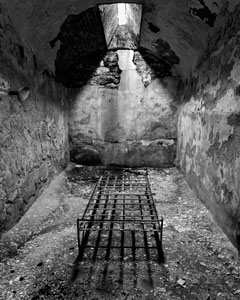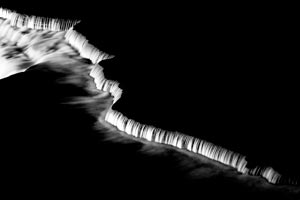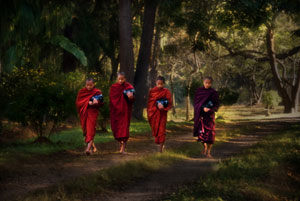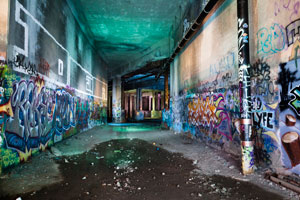
Gallery Photographers
Partner
Artists-in-Residence
Image City Feature Articles
Gary's Photographic Tips
Newsletter Archive
If you are unable to visit our gallery and would like to purchase photographs from this preview or others in the gallery, please contact the gallery and call 585-271-2540.
Gallery Picks of the Show
Portfolio Showcase 2011
Peter Marr picked his favorite photos of the show from the Portfolios
and also describes the strength of the images he has chosen.
All images copyright by the individual photographers
Penitentiary 7 by Steve Malloy Desormeaux Steve’s poignant and haunting black and white photographs from inside a derelict penitentiary, superbly evokes horror, abandonment and tragedy, so that there can be no disillusionment in the observer’s mind, that such penal institutions are lamentable and shocking places. Each of his eight masterly prints are creatively expressive, and his exemplary use of available light, which is essentially single-sourced, dramatically highlights astonishing detail, form and texture. All of the author’s images are fascinating and inspiring, making my selection of one to comment further on, extremely difficult. I finally chose print #7 because it is the best illustration of what you do not see, that is so vitally important. Here, a single, rusted bed frame offers both a dimensional indicator, and more meaningfully, a chilling reminder of how solitary confinement in such a forbidding prison cell, must have been a devastating experience for any luckless inmate. This claustrophobic enclosure of sheer unclimbable walls, offered little solace or hope of escape, and even the shaft of light from the narrow slit in the ceiling was just illusory. Sadly, such stark, inhospitable quarters only feeds more despair and hopelessness, and that crevice of light only connects to an outside imaginary world. The single, bulb-less fixture, controlled only from outside the cell, and the absence of any comforts whatsoever, is further evidence of the harshness of the treatment that occupants had to endure. The decaying walls and accumulated detritus, draws an immediate comparison to what may have taken place also in the minds and bodies of unfortunate inmates. Such inhumanity evokes both shock and sadness, so the observer may not want to dwell at length at the life and eventual fate of any criminal who had the misfortune to have been incarcerated here, let alone to ponder as to whether the punishment fitted the crime. Foreshadow by Tim Fuss In Tim’s truly excellent black and white prints, he has referenced various human experiences as viewed in the waters of upstate New York. All of his images are dynamic and thought-provoking, making the choice of just one to comment on extremely difficult. I finally selected Foreshadow, and in addition, I will relate what this print means to me in terms of human perception. I should note that waterfalls have emotional appeal, and as we cannot grasp the physical details of water in motion, we are therefore free to interpret them in any terms that we please. In Tim’s powerful print, there are two large expanses of intense blacks, which for some are negative space par excellence, but to me, they remind me of how incomprehensible the vastness of time is for human beings. Coupled with this, is the fact that black is a space in which forms move from as an active force or repeating rhythm, and in this image we have an exquisite ribbon of an irregularly curved water cascade, that sensually and rhythmically, traverses diagonally across the available space. This moving water creates contrasts of brightness, which are at the core of visual perception and design, which here forms both natural and graphic formations and introduces perspective. Here we see water as a dynamic and expressive medium, constantly changing its image and its sound, going from a gentle babbling and murmuring overflow at the bottom right, all the way to the crescendo of the thunder of a cataract as the water plunges over the cascade at the top left of the frame. In terms of human expression, I see the vast expanses of black as seas of normality, countless years of past experiences buried in the subconscious, both eventful and uneventful, part of life’s cyclical occurrences. The intervening cascading water is importantly irregular, in the path upward, mirroring significant life episodes, some more important than others, but they are ones we remember. Some of these encounters spill over into more dramatic events, where we relate to water’s moods and the sheer magnitude of its energy and sound as it plunges over the cataract. I hope that other observers of this outstanding print will try and visualize how this ribbon of waterfalls relate to their own life experiences. Morning Walk for Alms by Chris Kogut How could anyone not be excited and entranced by Chris’s creative portfolio, which impressively illustrates the rich historical and cultural tradition and diversity of Burma, all proudly being sustained in spite of the non-existent harmony between the current ruling regime and the citizens of this great country. I greatly admire all of her eight prints, but as I can only comment on one of them, I chose Morning Walk for Alms because for me it personifies the belief that moral order of man and the natural order of heaven and earth are inextricably linked, a Burmese philosophy shared with the people of China. Set in a delightful, scenic woodland of overarching trees, with the magic of quiet side-lighting splashing through the dense foliage, there is an aura of mystical atmospheric presence. Here, in a timeless early morning ritual, along a well-trodden pathway, four Buddhist monks devoutly make their way, journeying probably to the temple, following the footsteps of countless others who have used this route for many centuries. The soft light beautifully captures every facet of their features and clothing, giving the monks an ambience of reverence, piety and resolution that is just awesome. The brilliant red of the cloaks that are artfully and symbolically worn by the three monks, contrast resplendently with the bright blue alms bowls carried preciously in their left arms and hands. The fourth monk is wearing a dark blue habit, signifying that possibly he is a novice whilst his three companions probably are not yet ordained to full lama status. It is very evident that all four men are deeply into prayer and meditation, oblivious to any external noise, even to the sound their bare feet make on the rough terrain. The unique life and revered position of monks in their religious quest for love, happiness and oneness with Buddha and the universe, is very apparent in this memorable image. Their nirvana is one of threatened reality, yet their strong faith and beliefs will ultimately triumph over all of the oppressive measures that their adversaries implement. Appropriated Landscape #8 by James Prutilpac In the author’s excellent portfolio of artistically defaced structures, I am reminded of a quotation from Duane Michals, namely, “Photography deals exquisitely with appearances, but nothing is what it appears to be.” Here, parts of the Rochester landscape, including the aqueduct, have been appropriated by talented graffiti artists as background canvases for their spray painting expertise. Impressively, the author has aesthetically used a lot of artificial lighting in each of his prints to photograph these epic scenes to give us truly memorable images. The #8 print is an outstanding example of how imaginative lighting has transformed this usually dull and dreary aqueduct into a highly colorful, vibrant thoroughfare. The radiant light from all of the open alcoves and arches add a tremendous three-dimensionality to the image, without distracting us from admiring the consummate artistry of the graffiti on the walls and massive columns. Whilst admiring the vividly-hued designs and writings, we are aware that all lines, even the dark shadows, inextricably try to draw our attention to the black rectangle at the end of the passageway. Realizing this, the author added an element, or should I say series of elements, that not only was a creative and magical touch, it resulted in introducing a powerful mystery quotient. I refer of course to loops of blue lights, that culminate half way down the aqueduct into ghostly apparitions of people, when the lights are superimposed on faces that were painted on some of the massive columns that support the aqueduct. For myself, I first see a disused canal channel, important in its time, which has been revitalized by the graffiti artists, and secondly, I see a new awakening, where the ghosts of past frequenters of this stately avenue, reviving their past, and coming out to marvel at the new artistic defacements before they go back into the mysterious black rectangle, hopefully to return at the next opportune time. 



Image City Photography Gallery ♦ 722 University Avenue ♦ Rochester, NY 14607 ♦ 585.271.2540
In the heart of ARTWalk in the Neighborhood of the Arts